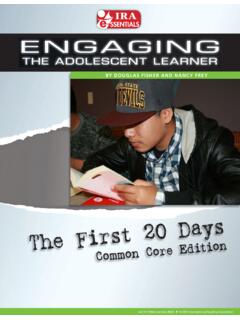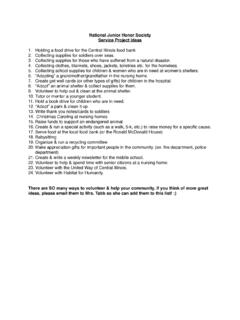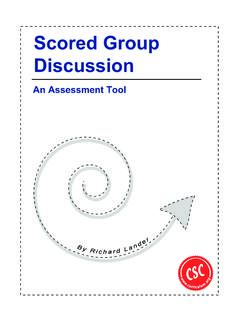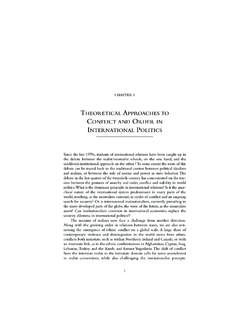Transcription of Facts for Teens: Conflict Resolution
1 Toll-Free: 1-866-SAFEYOUTH (1-866-723-3968) TTY: 1-800-243-7012 FAX: 301-562-1001 Facts for teens : Conflict Resolution Introduction All too often, small incidents and minor disagreements can lead to serious violence among teenagers1: One teenage boy teases or insults another. A teenage girl accuses another of spreading untrue gossip. One teen pushes, bumps, or shoves another. A teen takes or destroys another's possessions. Words are exchanged, tempers flare, conflicts escalate, and all too often, violence results. Unfortunately, many teens believe that when a Conflict or disagreement arises, they have no choice but to fight. Some see fighting as the only acceptable way to resolve They do not know of any way to avoid a fight without losing face.
2 Others do not know how to control themselves in the face of a perceived insult. In one survey of junior and senior high school students: 33 percent said that when they were really angry there was no way they could control themselves. 41 percent said that if they were challenged, they would fight. 21 percent said that avoiding fights was a sign of In a 1999 national survey, more than one in three high school students said they had been in a physical fight in the past While conflicts and disagreements are an inevitable part of life, they do not have to lead to violence. Around the country, many schools and community groups offer Conflict Resolution programs for teens . Through these programs, teens are learning about new ways to work through and resolve disputes, reducing the possibility of violence.
3 Most programs teach teens a series of steps to follow in resolving conflicts (although the exact steps may vary somewhat among programs).5, Box 6003 Rockville, MD 20849-6003 Facts for teens : Conflict Resolution , NYVPRC, Page 2 Toll-Free: 1-866-SAFEYOUTH (1-866-723-3968) TTY: 1-800-243-7012 FAX: 301-562-1001 Steps to Conflict Resolution 1. Set the stage. Agree to try to work together to find a solution peacefully, and establish ground rules ( , no name-calling, blaming, yelling, or interrupting). 2. Gather perspectives. Each person describes the dispute from his or her perspective, without interruption. Listeners pay close attention and then ask clarifying questions in a non-threatening manner. They consider not only what the other participants say they want, but why they want it.
4 For example, if someone insists that you pay for something they believe you broke, they may be doing so not because they really care about the object or the money, but because they feel that you don't respect them. Addressing the other person's need to feel respected may be key to resolving the Conflict . 3. Find common interests. Establish which Facts and issues all participants agree on and determine why different issues are important to each person. Identify common interests, which can be as simple as a mutual desire to resolve the problem without resorting to violence or a shared need to save face. 4. Create options. Take time for each teen to brainstorm about possible solutions to the problem. Come up with a list of options without immediately judging them or feeling committed to them.
5 Try to think of solutions where both people gain something-think win-win! Too often we assume that for one person to win, the other person has to lose. In reality, it is often possible to think creatively and come up with a solution that both people feel good about, where both walk away feeling that their needs have been met. 5. Evaluate options. After a number of options are suggested, each teen discusses his or her feelings about each of the proposed solutions. Participants will negotiate and often will need to compromise in order to reach a conclusion that is acceptable to both. They may need to agree to disagree about some issues to reach an understanding. 6. Create an agreement. The teens involved explicitly state their agreement and may even want to write it down.
6 If necessary, they set up a time to check back to see how the agreement is working. When teens use such an approach to resolve conflicts and disagreements, they often find that conflicts don't have to be avoided, nor do they necessarily lead to violence. Conflict can actually be a positive force in their lives; it can provide teens with an opportunity to take a close look at themselves and their attitudes and beliefs. If resolved positively, conflicts can actually help strengthen relationships and build greater Facts for teens : Conflict Resolution , NYVPRC, Page 3 Toll-Free: 1-866-SAFEYOUTH (1-866-723-3968) TTY: 1-800-243-7012 FAX: 301-562-1001 Schools and communities have developed a number of different types of Conflict Resolution programs8: Conflict Resolution training programs Conflict Resolution training programs involve a separate course offered in the school or community that explicitly teaches the principles of Conflict Resolution and necessary skills and abilities.
7 Peer mediation programs Peer mediation programs go beyond Conflict Resolution training and teach youth to act as mediators. Then, when other children and teens are not able to resolve conflicts on their own, the peer mediators can intervene and guide them through the Conflict Resolution process, trying to help them resolve disputes without resorting to violence. Peaceable classrooms and schools Some schools are now trying to incorporate Conflict Resolution education into all aspects of the classroom or the school environment. With such approaches , Conflict Resolution education is interwoven with all classroom teaching, and teachers and staff are encouraged to promote effective Conflict Resolution principles and practices through their own behavior and through discipline and management practices.
8 Community mediation centers Community mediation centers can be found in many communities. Typically based in nonprofit community-based agencies, these centers use trained community volunteers to provide mediation services to youth and adults. The centers mediate many types of disputes involving youth, including those involving gangs, graffiti, loitering, school suspensions, truancy, and parent/child relationships. Many of these centers also provide training for youth in the community to become mediators. Do Conflict Resolution programs actually reduce violence? At this time, the effectiveness of most Conflict Resolution programs in reducing physical violence has not been adequately assessed. When studies have been conducted, some programs have shown no impact on aggressive behavior, while a few have been shown to reduce aggressiveness, violence, dropout rates, and student suspensions.
9 A number of programs have been shown to be effective in improving academic performance and increasing cooperation, communication skills, assertiveness, self-esteem, and , 10 For a description of programs that have demonstrated some positive impact on aggressive attitudes and/or behavior, see Best Practices of Youth Violence Prevention: A Sourcebook for Community Action ( ) from the Centers for Disease Control and Prevention. What You Can Do Learn about ways to resolve arguments and conflicts peacefully, and encourage your friends to do the same. Many schools, churches, community organizations, and after-school programs offer training in Conflict Resolution skills. In the meantime: Facts for teens : Conflict Resolution , NYVPRC, Page 4 Toll-Free: 1-866-SAFEYOUTH (1-866-723-3968) TTY: 1-800-243-7012 FAX: 301-562-1001 Figure out what methods work for you to control your anger (like leaving a tense situation temporarily or finding a calm person to talk to) and use them before losing control.
10 If you feel intensely angry, fearful, or anxious, talk about it with an adult you trust, such as a parent, teacher, or counselor. Think beforehand about what the consequences of different ways of resolving a Conflict will be: anger and violence versus finding a peaceful way to resolve a dispute. Do not carry a gun or other weapon and don't associate with people who do carry weapons. Weapons escalate conflicts and increase the chances that you will be seriously harmed or that you will accidentally harm someone else. It is illegal for a teen to carry a handgun, and it can lead to criminal charges and arrest. Avoid or use caution in places or situations where conflicts and disputes tend to arise. In many schools, conflicts tend to arise in certain places or situations, often due to over-crowding or a lack of supervision.



















